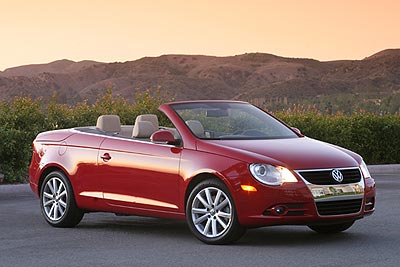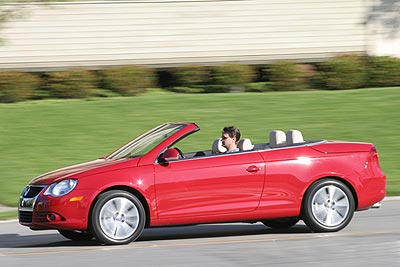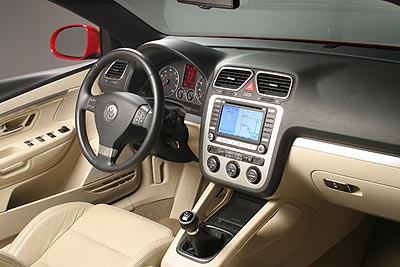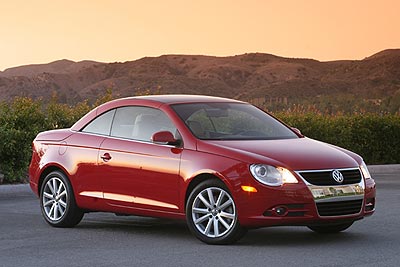Recent Articles
Popular Makes
Body Types
2007 Volkswagen Eos Review
The one car guys will be begging their wives to buy

Volkswagen Eos – Review: Guys buy towels because they’re marked two for $5, not because they’re soft. We have no tolerance for creams and lotions, and if there’s an unusual bump somewhere, it comes off with sandpaper. That’s just the way it is, until the day when we’re introduced to the other side of the coin, at which time we seriously consider the value of thread counts, and we contemplate the possibility that Lava soap may not be intended for shower use. Such thoughts are usually accompanied by the introduction of a wife or girlfriend, one who just might be driving a new Volkswagen Eos. The thing screams “chic car” and we’re sure it drives accordingly. Problem is, it doesn’t. With its eager turbocharged engine, slick six-speed manual transmission, responsive handling, and quality construction, the Eos is actually a car we, well, like. Maybe not enough to buy one ourselves, mind you – we’ll go to the GTI, GLI, or Passat if we’re jonesin’ for VW fun that much – but keeping it nearby definitely outranks Sex and the City DVD night as a reason to work on our current relationship. A $36,110 Volkswagen? Such was the first question that came to mind when we saw the window sticker for our Paprika Red 2007 Eos tester. It shouldn’t come as much of a surprise, given the going rates for Passats, GTIs, and Touaregs, not to mention competitors including the Chrysler Sebring Convertible and Volvo C70. The particular example supplied to us by VW was a 2.0T model with the standard six-speed manual transmission, a navigation system ($1,800), and a Sport Package ($3,690) including leather upholstery, aluminum trim, Sirius satellite radio and a six-disc CD changer, rain-sensing wipers, 12-way power adjustable front seats, and 17-inch alloy wheels. Add it all, along with the $630 destination charge, to the $29,990 base price, and you end up with one pricey Vee-Dub.
Performance
Kudos to Volkswagen for assembling one heck of an impressive powertrain. There are few times when our horsepower-addicted staff finds contentment in the smaller of two available engines, yet after experiencing the 200-horsepower 2.0-liter turbocharged four-banger once again (it’s the same engine found in the GTI, Jetta GLI, and Passat), we questioned the need for the larger 3.2-liter V6. Off-the-line acceleration is adequate, and within a blink of an eye the turbo has spooled up, resulting in an outpouring of power that causes the front tires to chirp and claw for traction. All of this happens in what seems a millisecond, so power delivery actually feels linear. Torque-steer is controlled, but there’s noticeable rear squat as the Eos charges forward. Passes at all speeds are effortless. The six-speed manual transmission on our tester featured fluid, short shifts, backed by an easy-effort clutch that felt notchy at times. After a week of aggressive driving, we recorded an average fuel economy rating of 21.6 mpg. Cars are often gauged by those who drive them. Last year, our editors had fun with the Eos on the track, but after one of our staffers noticed an older lady driving a light blue model around his condo complex, he wondered if his recollection of an athletic little German convertible was undeserved. An afternoon in the nearby mountains cleared away all doubt. Some may accuse the Eos of being too giving when pushed, but that’s just what others will love about it – soft for everyday driving, and yet firm enough to carve through the twisties with relative ease. The responsive steering offers a good dose of road feel, with understeer rearing its head only when corners are attacked with particular ferocity. The Eos is a joy to confidently toss when the road is anything but straight. As with other VWs we’ve tested, the brakes were the weakest point, though rather than the troublesome fade felt on the Jetta and GTI, the Eos’s stoppers simply shuddered under hard braking. Soft top convertibles offer notoriously poor visibility, but hard tops usually provide some improvement. Despite its hard top, the 2007 Volkswagen Eos falls about mid pack. Problems include a short windshield that’s further limited by a square rearview mirror that drivers have to actually look around at times, large front head restraints which limit the side view, and large non-adjustable rear head restraints that work with wide rear pillars to squash the benefits of a relatively large rear window. Side mirrors are adequate, but only designers would complain about them growing in size. To its credit, the Eos lacks a B-pillar, meaning there’s only glass from the A- to D-pillars that, if not for the aforementioned head restraints, would provide for impressive over-the-shoulder viewing. Call it the warped view of a single 30-something male, but one of our editors views the current crop of turbocharged VWs as the automotive equivalent to the perfect woman. At the heart is a lively, fun, and desirable 200-horsepower engine, preferably mated to a slick six-speed manual transmission, all of which is surrounded by quality materials. The fact that this little bundle of joy can be dressed up as a sport hatch, a civilized sedan or wagon, and now a stylish drop top, makes it all the more appealing. Kind of like that woman who’s up for a day at the beach, a night on the town, or a dinner with the ‘rents. The Eos is more than fun to drive – it’s fun in general.

Front Comfort
When you’ve got a seat that draws praise from small- and large-build adults for its comfort and support, you know you’re onto something. Despite the varying sizes of our editors and the beefy bolsters that served to limit the seats’ width, the front buckets in our Eos allowed each staffer to find a suitable driving position. When cornering, the substantial side cushions kept bodies firmly planted, though the lower bolster could have used more padding and the center console would benefit from knee-friendly soft-touch plastics. As equipped, our drop-top VW featured 12 power adjustments for driver and passenger, the former also enjoying a nice leather-wrapped tilt and telescoping steering wheel. There’s a welcome layer of padding on the door panels and sills, and the center armrest adjusts, though it needs to lock into place – weight and pressure from a resting forearm caused it to slide back and forth. The Eos also provides adequate leg and head room (with the top raised), but tight parking can be an issue with the wide and heavy doors. Who said VW engineers don’t have a sense of humor? Any average-size adult attempting to sit in the Eos’s rear so-called seat knows that’s not the case. The first clue comes when tilting the front seats forward, at which time one realizes they don’t also slide forward for easy entry. Finagle your way in, and if the narrow space doesn’t get to you, the upright seatback surely will. Side armrests are almost useless, but the large head restraints are a nice touch. Now if they could just be made adjustable for reasons of comfort and visibility. Front seatbacks are thankfully soft, though rear leg room is tight, as is head room. Soft-top convertibles are famous for being loud, while hard-top versions are more on the quiet side. The 2007 VW Eos keeps up the status quo in that regard, albeit not as well as other retractable hard-top models we’ve experienced. At highway speeds, the Eos’s interior is filled with a good bit of wind noise, lots of tire noise, and a somewhat muted thunk each time we encountered rough pavement. Those are the negatives. More pleasant was the muted and refined engine note, even at full throttle, with the occasional (OK, frequent) whoosh from the enticing turbocharger. Unlike most soft-top convertibles, which offer equal amounts of trunk room with or without the top raised, hard-top models like the Eos see a drastic drop in usable space when the sunny skies are calling. With the multi-piece top up, the cargo area consists of a decent center pocket, good for maybe one large suitcase or a couple of duffle bags, and some space on the sides. However, stickers in the trunk suggest that only the center area is suitable for storage. A narrow pass-through allows for extending some items into the rear seat, but don’t even think about toting a set of clubs. Dropping the top results in all of the roof and rear glass panels being stacked in the trunk – what you’re left with is the same central storage area, though it can only be accessed through a tight six-inch gap. Clearly, it’s best to stick with the stuffable duffles. Of course, the inhospitable rear seat is perfect for packing in some extra gear. A pair of switches located below the front center armrest controls the power top as well as the expansive glass sunroof. The small black switch is for the sunroof; the large silver switch lowers the roof in 24 seconds and raises it, along with all four side windows, in 30 seconds. The driver will need to .

Build Quality
With all of the moving panels, hard-top convertibles can pose a challenge in terms of gaps and overall build quality. When surveying the Eos, we did find that the gaps around the trunk lid were wider than expected, though they were consistent from side to side. Otherwise, the exterior was issue free. Moving to the interior, our nitpicky scribes noticed a few plastic panels failed to align properly and exhibited some unfinished rough edges, but as was the case with the exterior, the overall level of quality was impressive. Those familiar with current Volkswagen vehicles will expect, and subsequently find quality materials in the Eos convertible. Our well-equipped 2.0T test car featured durable leather on the face of the seats, soft hides on the steering wheel and shift knob, and padded low-gloss black plastic on the dash cap and door sills. All were pleasant to the touch and gave this Volkswagen and upscale feel. Also dressing up the cabin was a tight mesh material on the headliner and sunshade. Hard plastics decorated the rest of the Eos’s interior, most of which matched except for a somewhat tighter grain pattern on the lower door panels. To its credit, nothing inside the Eos felt cheap, though more soft-touch materials would have accompanied that $37,000 price tag quite nicely. With its curvaceous roofline mimicking that of a traditional coupe, elevating belt line, and stylish 17-inch alloy wheels, the Eos is an attractive package. The tall chrome grille has been a VW hallmark long enough that people are at least accepting it, and the bright LED taillights are an aesthetic and safety bonus. The absence of B-pillars affords the Eos a clean side profile appearance. Form and function are equally addressed inside, where contrasting colors and silver accents dress things up a bit, and well laid out controls give a nod to superior ergonomics. But put it all together, and you come up with a ride that’s somehow ladylike. Let’s just say that when one editor’s neighbor suggested the Eos was a “chic magnet” he didn’t exactly agree. Storage space inside the Eos is adequate, yet hardly abundant. Included are ample door pockets, a rubber-lined and covered slot forward of the shifter, a small card slot below the center armrest, and a spacious, damped, and lockable glovebox. There are also small pockets on the front seat backs. That’s where the adequate part comes in. Abundant would require more than a tiny slot under the center armrest, an increase over the two non-adjustable front cupholders, and some sort beverage holder for those theoretical rear passengers.

Infotainment Controls
Perhaps it’s a German thing. Just like the Mercedes-Benz E320 Bluetec we tested a couple weeks back, the Volkswagen Eos features a navigation system devoid of touch-screen controls. C’mon people – even the 2008 Saturn VUE we’ve got in the office this week has a touch-screen nav system. At least the VW’s setup is easy to use, offers a high-resolution map, and includes a clearly-marked button for switching between day and night brightness settings. Most of the radio controls are buried in the navigation system with the exception of equalizer, band, and mute buttons. We’d prefer controls that could be accessed quickly, along with larger dials than those provided for volume and tuning. However, the illuminated steering wheel audio controls are a welcome feature. Controlling the climate settings within the Volkswagen Eos is generally a straight-forward affair, with a few quirks thrown in for good measure. Three dials address driver temperature, passenger temperature, and fan speed, while buttons take care of fan direction, defrost, and other secondary functions. There are even small digital screens that display the different temperature settings for driver and passenger. So far, so good. Then there are the knobs for the front heated seats. They’re a must-have in convertibles, and the availability of five settings makes sure each body is kept comfortable. But the “on” light isn’t distinguishable in daylight and blends in with all the other dash lights at night, leaving one to question whether the seats are being heated or if too many beans were consumed with last night’s dinner. There was only one button that temporary eluded us, and coincidentally, it was tied to a feature that is seldom associated with convertibles. We’re talking about the power sunroof, which as we discovered, requires use of a switch below the center armrest. It’s integrated with the power retractable hard top switch, a coupling that makes complete sense. Once you find them, that is. All of the typical power functions feature buttons where we’ve all come to expect, and the ESP (stability control) off button is clearly labeled in the center console. The front power windows include and auto up/down function, and all four windows can be raised or lowered with one handy button.

Competition
While there are a number of four-passenger convertible competitors with which the 2007 Volkswagen Eos battles for sales, are equipped with a retractable hard top. Among them are the 2008 Chrysler Sebring Convertible, the 2007 Pontiac G6 Convertible, and the 2007 Volvo C70. The first to hit the streets was the Volvo, a model that starts at about $40,000, followed by the Pontiac, which claimed to be the only sub-$30,000 hard top convertible, until that is, the Eos with its $28,000 base price arrived. The last to arrive was the Chrysler Sebring Convertible, starting in the $26,000 neighborhood and, like the others, running well into the $30,000s as the equipped is piled on. As a convertible junkie, the only thing that keeps me from lowering a convertible’s top are the words “torrential” or “whiteout” in the weather forecast. So I ignored the growing tickle in my throat and opened up the Eos on a clear, cool 55-degree morning commute. With plenty of juice from the turbocharged engine, a comfortable interior that warmed right up with the seat warmers on “fry” and the heater on “blast,” I can say that the coming week of honey-lemon tea and salt water gargles was worth it. The fully loaded price of $36,000 is a lot, but then again, Chrysler thinks it can charge a similar fee for its clearly inferior Sebring convertible, so what the hell, why not? - Keith Buglewicz Open air, top up or down, yes its possible with the new Volkswagen Eos. Well, almost, the Eos is equipped with a large sunroof that works separately from the hardtop for those days when you want just a little fresh air. The turbo charged four-cylinder engine pulls hard and is smooth all the way to redline, and feedback from the brakes and steering is excellent. Top up, the exterior design carry’s a unique look, but with the top down the design becomes mainstream. With the top retracted I experienced a slight bit of cowl shake but nothing to get excited over and overall I give the Eos high marks for comfort and drive ability. I would definitely recommend it for those desiring a retractable hardtop. - Ron Perry Good looks still count. If not for its odd proportions, droopy eyes, and chromed nose, I would seriously consider buying (well, actually leasing since I wouldn’t want to wind up paying for repairs to the complicated power retractable roof) a Volkswagen Eos. Volkswagen turbos are simply a kick to drive, and not just because of their seamless power. The cars communicate the nuances of the road while delivering an absorbent ride quality, and if you can live with some extra body roll the trade-off is worthwhile for daily commuting. Plus, the driving position is perfection thanks to terrific seats, a tilt and telescopic steering wheel that is a joy to hold, a softly padded adjustable center armrest, and a fluid shifter that falls readily to hand. What’s ultra-cool about the Eos is its top. Sure, it’s a power retractable hardtop but it also contains a large glass sunroof over the front seats. The effect with the roof closed is an airy cabin with terrific visibility. Open the sunroof and pop the wind blocker up to enjoy sunshine and a big trunk. Or, keep the extra stuff to a minimum and power the entire roof down. Add the fact that four people can fit inside (this car would be great for families with kids who have graduated from booster seats but haven’t hit their teenage years), and the Eos is a winner in my book despite its rather hefty price tag. If only it looked like something I wanted to be seen in. – Christian Wardlaw Photos courtesy of: Ron Perry
